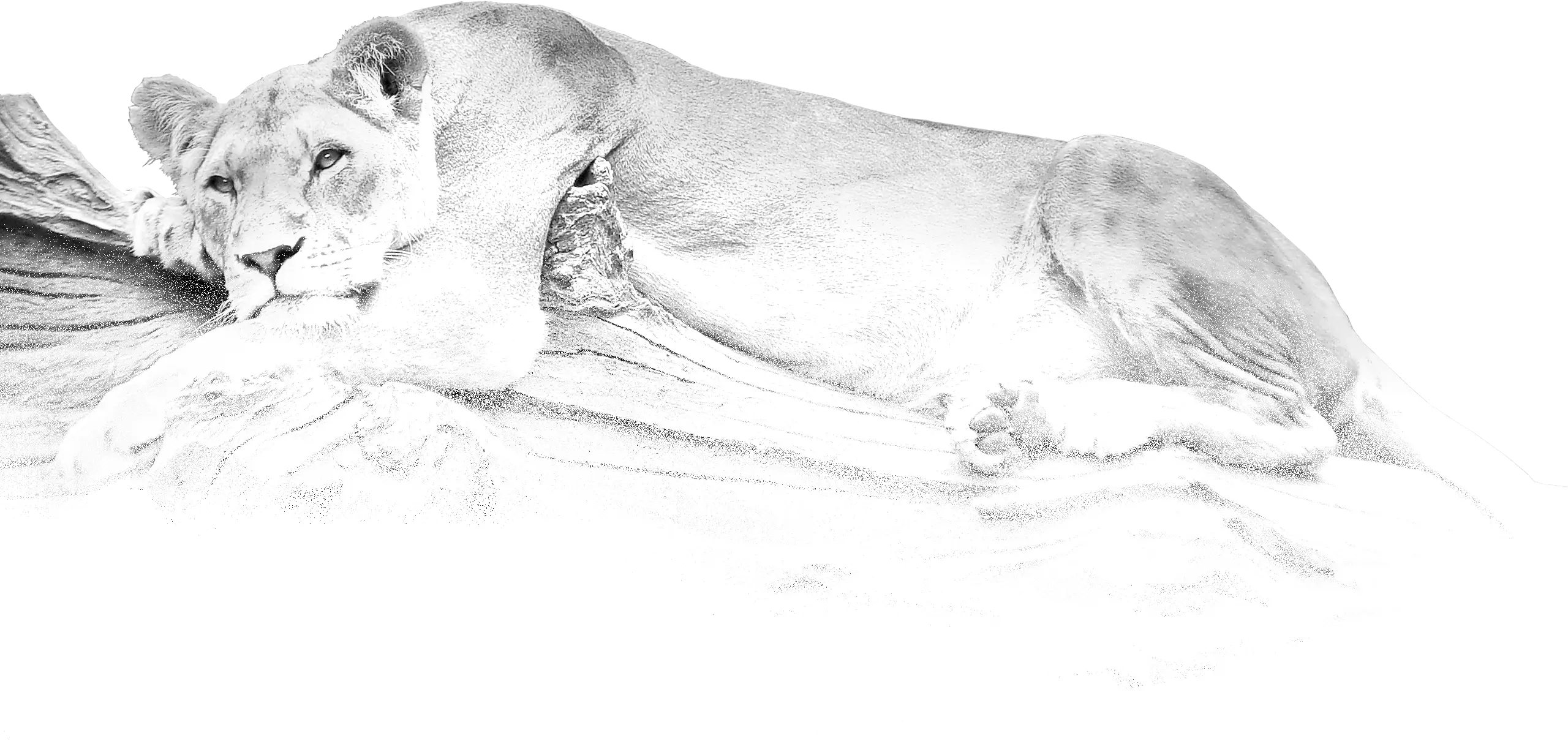
(Phocidae)
Earless Seals
Тюленеві
The earless seals, phocids, or true seals are one of the three main groups of mammals within the seal lineage, Pinnipedia. All true seals are members of the family Phocidae. They are sometimes called crawling seals to distinguish them from the fur seals and sea lions of the family Otariidae. Seals live in the oceans of both hemispheres and, with the exception of the more tropical monk seals, are mostly confined to polar, subpolar, and temperate climates. The Baikal seal is the only species of exclusively freshwater seal.
The social structure of phocids varies from species to species. Some are monogamous or associate in small groups, while elephant seals are highly gregarious and polygamous. Most seals differ from sea lions, however, in that they do not congregate in the huge rookeries. Some species are migratory. Seals are accomplished divers. Their ability to reach great depths and stay under water for prolonged periods varies considerably from species to species. The champion diver may be the Weddell seal, which is known to reach depths of 600 m and to stay submerged for more than an hour.
External anatomy
Adult phocids vary from 1.17 m in length and 45 kg in weight in the ringed seal to 5.8 m and 4,000 kg in the southern elephant seal, which is the largest member of the order Carnivora. Phocids have fewer teeth than land-based members of the Carnivora, although they retain powerful canines. Some species lack molars altogether. The dental formula is 2-3/1-2, 1/1, 4/4, 0-2/0-2 = 26-36.
While otariids are known for speed and maneuverability, phocids are known for efficient, economical movement. This allows most phocids to forage far from land to exploit prey resources, while otariids are tied to rich upwelling zones close to breeding sites. Phocids swim by sideways movements of their bodies, using their hind flippers to fullest effect. Their fore flippers are used primarily for steering, while their hind flippers are bound to the pelvis in such a way that they cannot bring them under their bodies to walk on them. They are more streamlined than fur seals and sea lions, so they can swim more effectively over long distances. However, because they cannot turn their hind flippers downward, they are very clumsy on land, having to wriggle with their front flippers and abdominal muscles.
Phocid respiratory and circulatory systems are adapted to allow diving to considerable depths, and they can spend a long time underwater between breaths. Air is forced from the lungs during a dive and into the upper respiratory passages, where gases cannot easily be absorbed into the bloodstream. This helps protect the seal from the bends. The middle ear is also lined with blood sinuses that inflate during diving, helping to maintain a constant pressure.
Phocids are more specialized for aquatic life than otariids. They lack external ears and have sleek, streamlined bodies. Retractable nipples, internal testicles, and an internal penile sheath provide further streamlining. A smooth layer of blubber lies underneath the skin. Phocids are able to divert blood flow to this layer to help control their temperatures.
Communication
Unlike otariids, true seals do not communicate by “barking”. Instead, they communicate by slapping the water and grunting. True seals have also been documented to clap at each other underwater. One study published in Animal Behaviour found that seals use rhythmic percussive signalling in both “agonistic interactions” and display behavior.
Movements
With short front flippers and because their rear flipper is unable to rotate, true seals cannot walk when out of the water like sea lions. As a result, they bounce themselves forward in a motion called galumphing; the polar explorer Edward Wilson referred to the motion as lolloping.
Reproduction
Phocids spend most of their time at sea, although they return to land or pack ice to breed and give birth. Pregnant females spend long periods foraging at sea, building up fat reserves, and then return to the breeding site to use their stored energy to nurse pups. However, the common seal displays a reproductive strategy similar to that used by otariids, in which the mother makes short foraging trips between nursing bouts.
Because a phocid mother’s feeding grounds are often hundreds of kilometers from the breeding site, she must fast while lactating. This combination of fasting with lactation requires the mother to provide large amounts of energy to her pup at a time when she is not eating (and often, not drinking). Mothers must supply their own metabolic needs while nursing. This is a miniature version of the humpback whales’ strategy, which involves fasting during their months-long migration from arctic feeding areas to tropical breeding/nursing areas and back.
Phocids produce thick, fat-rich milk that allows them to provide their pups with large amounts of energy in a short period. This allows the mother to return to the sea in time to replenish her reserves. Lactation ranges from five to seven weeks in the monk seal to just three to five days in the hooded seal. The mother ends nursing by leaving her pup at the breeding site to search for food (pups continue to nurse if given the opportunity). “Milk stealers” that suckle from unrelated, sleeping females are not uncommon; this often results in the death of the mother’s pup, since a female can only feed one pup.
Growth and maturation
The pup’s diet is so high in calories that it builds up a fat store. Before the pup is ready to forage, the mother abandons it, and the pup consumes its own fat for weeks or even months while it matures. Seals, like all marine mammals, need time to develop the oxygen stores, swimming muscles, and neural pathways necessary for effective diving and foraging. Seal pups typically eat no food and drink no water during the period, although some polar species eat snow. The postweaning fast ranges from two weeks in the hooded seal to 9–12 weeks in the northern elephant seal. The physiological and behavioral adaptations that allow phocid pups to endure these remarkable fasts, which are among the longest for any mammal, remain an area of active study and research.
Feeding strategy
Most seals feed on fish, squid, octopus, and shellfish, but some take plankton, and one species catches penguins and small seals.
Phocids make use of at least four different feeding strategies: suction feeding, grip and tear feeding, filter feeding, and pierce feeding. Each of these feeding strategies is aided by a specialized skull, mandible, and tooth morphology. However, despite morphological specialization, most phocids are opportunistic and employ multiple strategies to capture and eat prey. For example, the leopard seal (Hydrurga leptonyx) uses grip and tear feeding to prey on penguins, suction feeding to consume small fish, and filter feeding to catch krill.
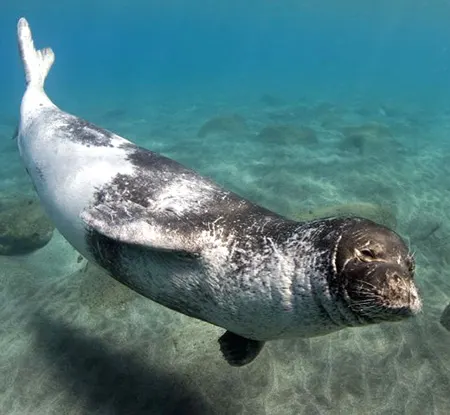
(Monachus monachus)
Mediterranean Monk Seal
Тюлень-монах звичайний
It can be found in the Mediterranean Sea, off the coasts of Croatia, Cyprus, Greece, and Turkey, as well as in the North Atlantic Ocean, off Mauritania, Western Sahara, and the archipelago of Madeira.
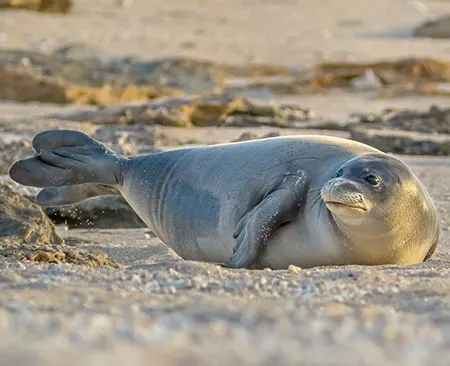
(Neomonachus schauinslandi)
Hawaiian Monk Seal
Тюлень-монах гавайський
The majority of it can be found around the Northwestern Hawaiian Islands, but a small and growing population lives around the main Hawaiian Islands.
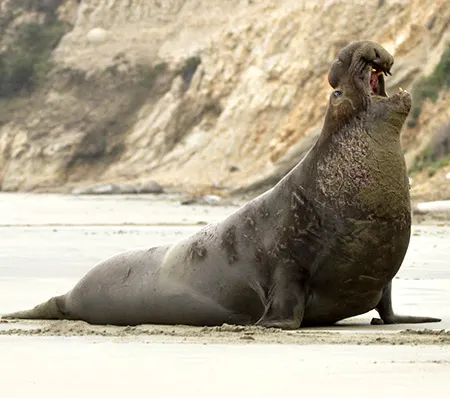
(Mirounga angustirostris)
Northern Elephant Seal
Морський слон північний
It is found in the Aleutian Islands and in the coastal waters of the Pacific Ocean, ranging from the Gulf of Alaska to Baja California.
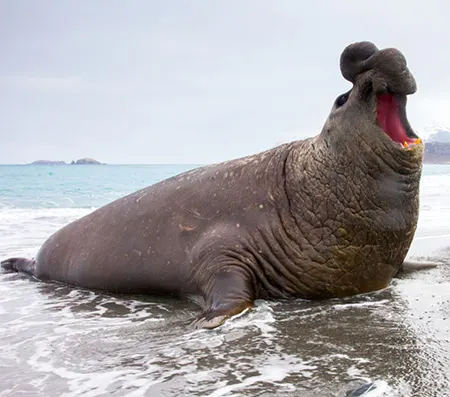
(Mirounga leonina)
Southern Elephant Seal
Морський слон південний
It inhabits large portions of the southern hemisphere. This includes lands in Antarctica and islands in the southern part of Africa, South America, and Australia.
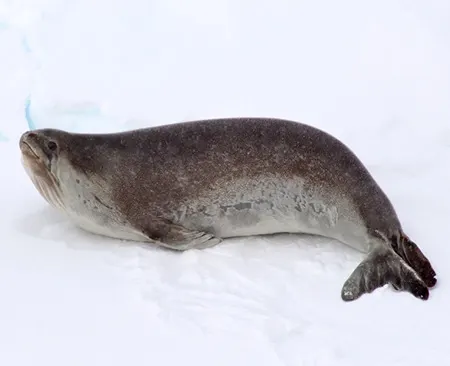
(Ommatophoca rossii)
Ross Seal
Тюлень Росса
Its range is confined entirely to the pack ice of Antarctica and does not extend farther north than 60° S latitude.
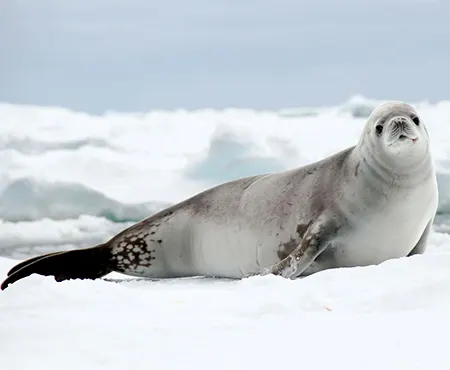
(Lobodon carcinophaga)
Crabeater Seal
Тюлень-крабоїд
It is found mainly on the coast and pack ice around Antarctica. In the winter months, it may be found on the shores of South America, Australia, South Africa, Tasmania, New Zealand, and various islands surrounding Antarctica.
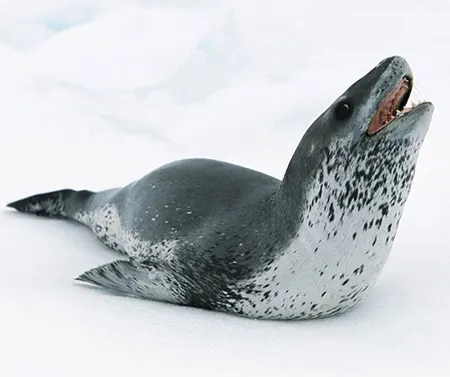
(Hydrurga leptonyx)
Leopard Seal
Морський леопард
It primarily inhabits the Antarctic pack ice between 50°S and 80°S, with higher densities observed in West Antarctica.
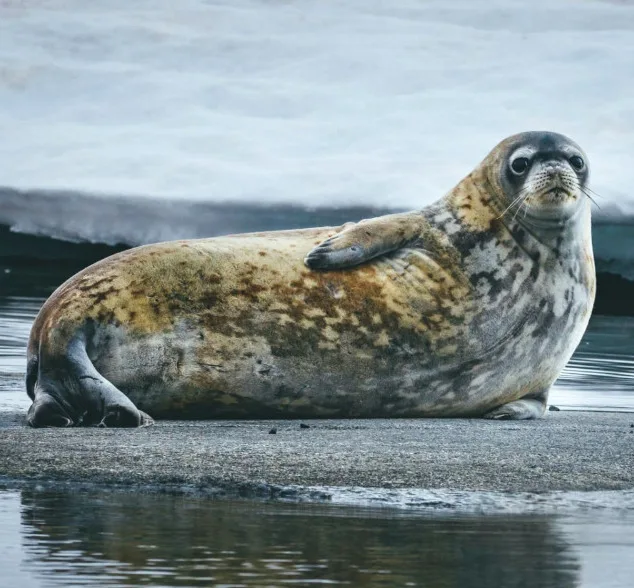
(Leptonychotes weddellii)
Weddell Seal
Тюлень Ведделла
It has a circumpolar distribution surrounding Antarctica and is also found on fifteen small neighboring islands.
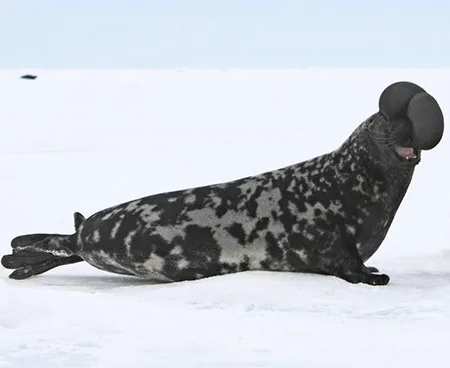
(Cystophora cristata)
Hooded Seal
Чубач плямистий
It lives mainly on drifting pack ice and in the deep waters of the Arctic Ocean and the North Atlantic.
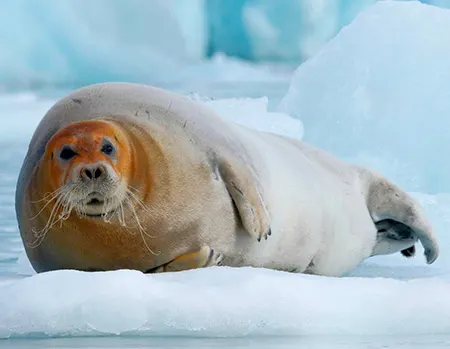
(Erignathus barbatus)
Bearded Seal
Лахтак бородатий
In the Pacific, its range extends from the Chukchi Sea southward to the Bering Sea and the Sea of Okhotsk. In the Arctic Ocean, it inhabits the northern coasts of Russia, Norway, Canada, and Alaska, including Svalbard and the Canadian Arctic Archipelago. In the Atlantic, it is found along the northern coast of Iceland, both coasts of Greenland, and the Canadian mainland as far south as Labrador.
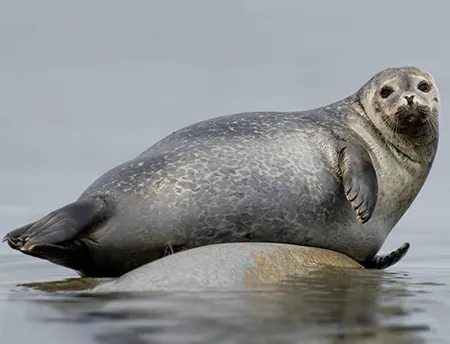
(Phoca vitulina)
Harbor Seal
Тюлень звичайний
It is found along temperate and Arctic marine coastlines of the Northern Hemisphere and inhabits the coastal waters of the northern Atlantic and Pacific Oceans, as well as the Baltic and North Seas.
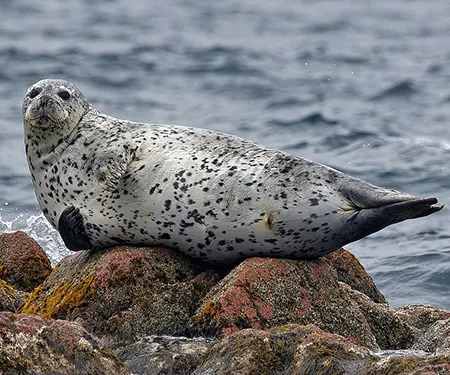
(Phoca largha)
Spotted Seal
Тюлень плямистий
It inhabits ice floes and the waters of the North Pacific and adjacent seas. It is commonly found in the Bering, Chukchi, Beaufort, and Okhotsk Seas, where it prefers to remain over the continental shelf. It can also be found in the Sea of Japan and the Yellow Sea.
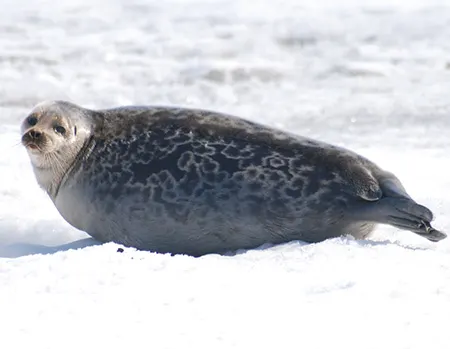
(Pusa hispida)
Ringed Seal
Нерпа кільчаста
It occurs throughout the Arctic Ocean and adjacent seas. It can also be found in the Baltic Sea, Lake Ladoga in Russia, Lake Saimaa in Finland, and the Sea of Okhotsk near Japan.
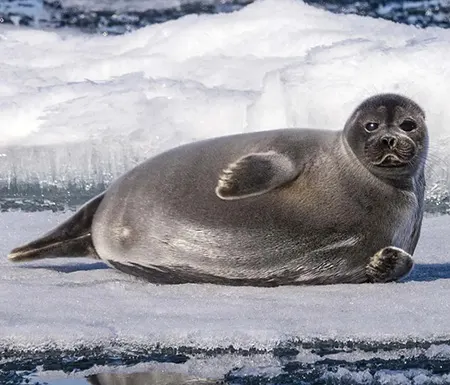
(Pusa sibirica)
Baikal Seal
Нерпа байкальська
It is endemic to Lake Baikal in Siberia, Russia.
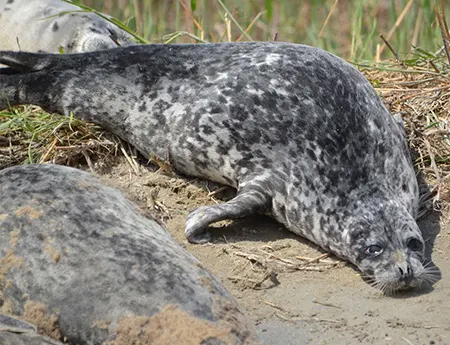
(Pusa caspica)
Caspian Seal
Нерпа каспійська
It is found exclusively in the brackish Caspian Sea. It lives along the shorelines, but also on the many rocky islands and floating blocks of ice that dot the Caspian Sea.
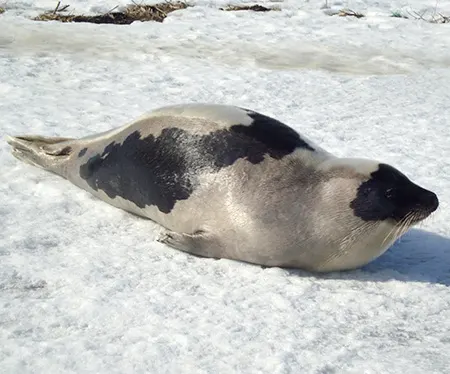
(Pagophilus groenlandicus)
Harp Seal
Лисун гренландський
It is distributed from the Canadian Archipelago and the Labrador Peninsula eastward to the Barents Sea and Kara Sea in northern Russia.
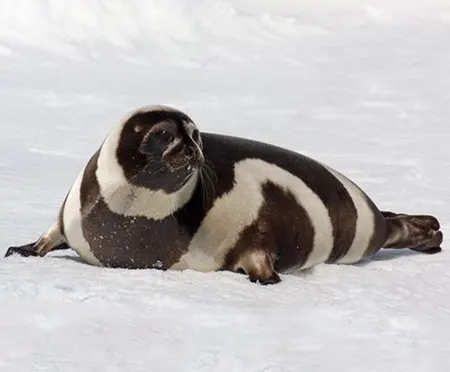
(Histriophoca fasciata)
Ribbon Seal
Крилатка
It is native to Arctic regions, occurring throughout icy waters of the northern Pacific Ocean and southern Arctic Ocean. In winter, it can be found along the ice front in the Bering and Okhotsk Seas.
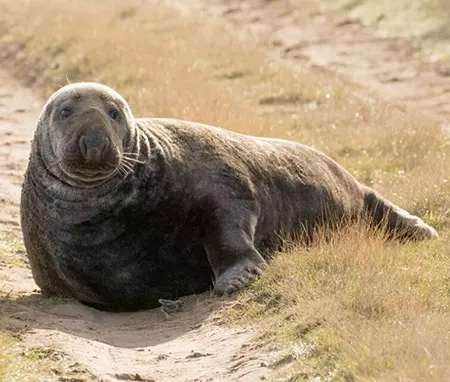
(Halichoerus grypus)
Grey Seal
Тев'як довгомордий
There are three isolated populations: the Baltic (Baltic Sea), the East Atlantic (North Sea, English Channel, Irish Sea, Norwegian Sea, Barents Sea, and the coasts of Iceland and the Faroe Islands), and the West Atlantic (coasts of Newfoundland, the Labrador Peninsula, and the extreme northeastern United States).

